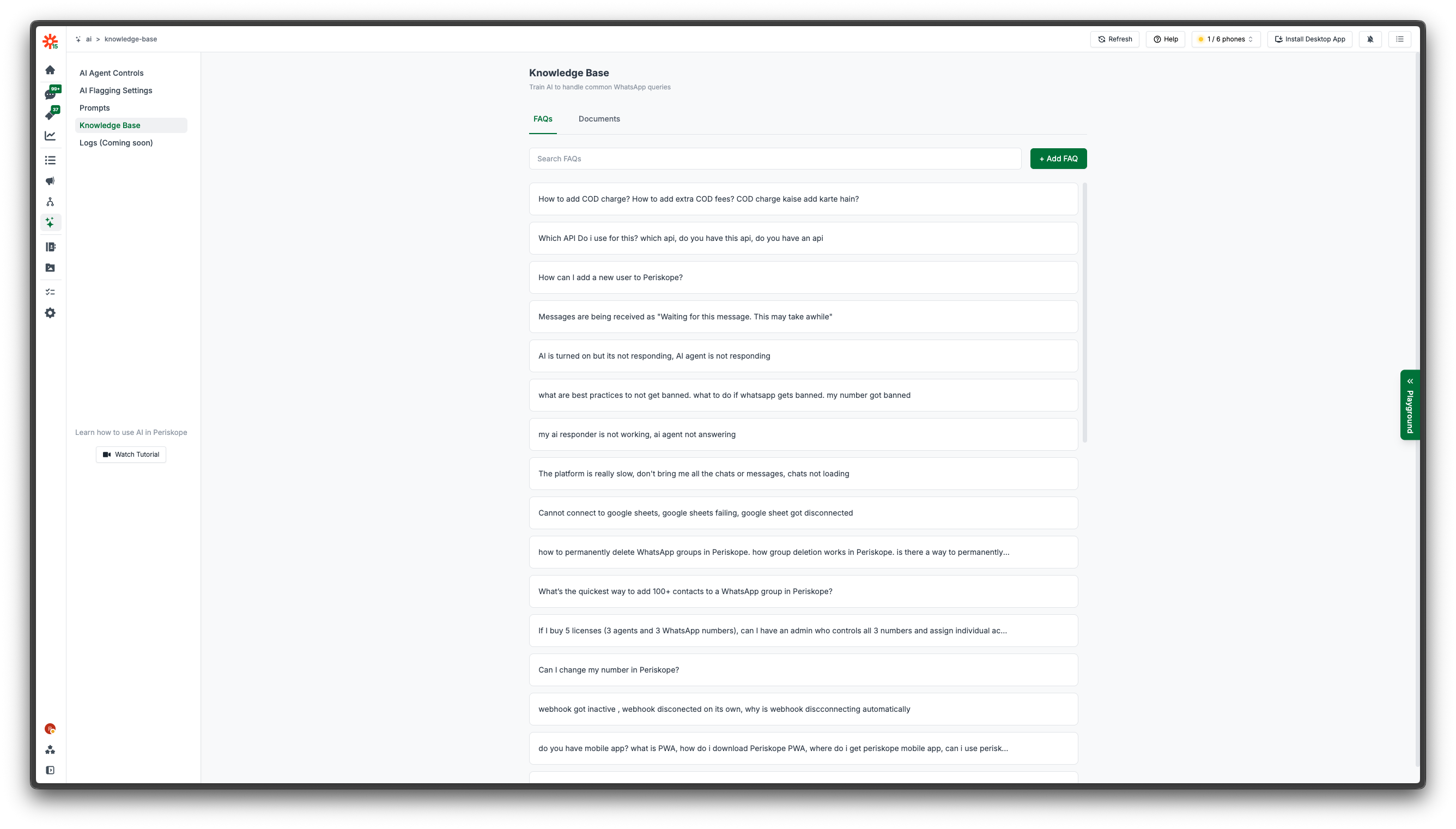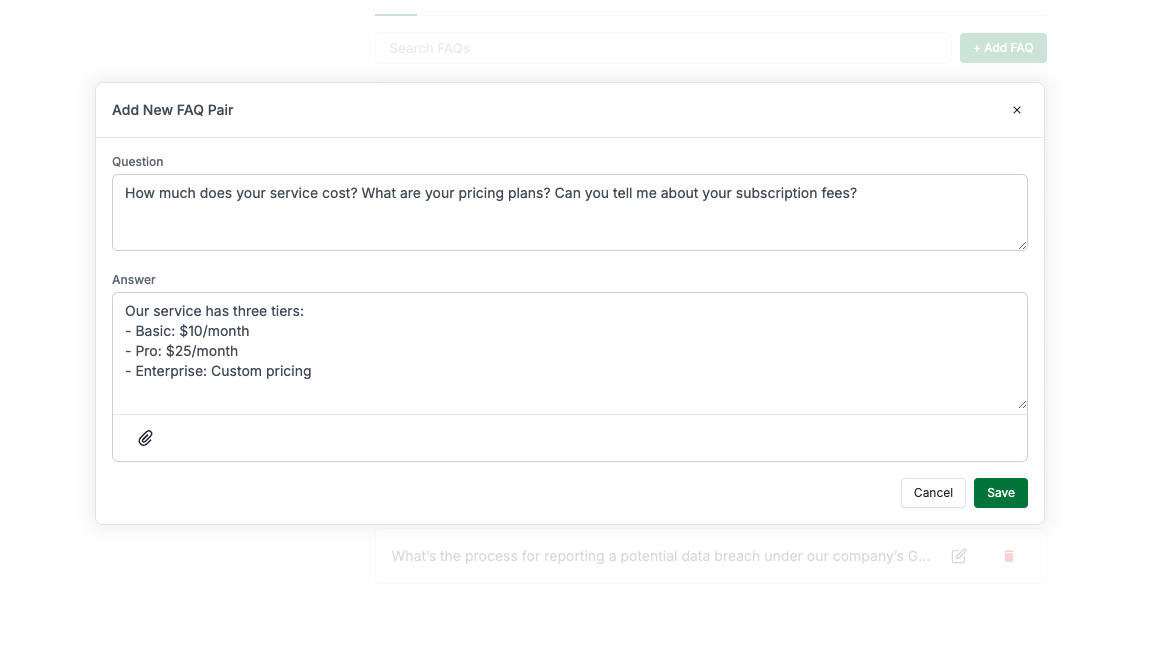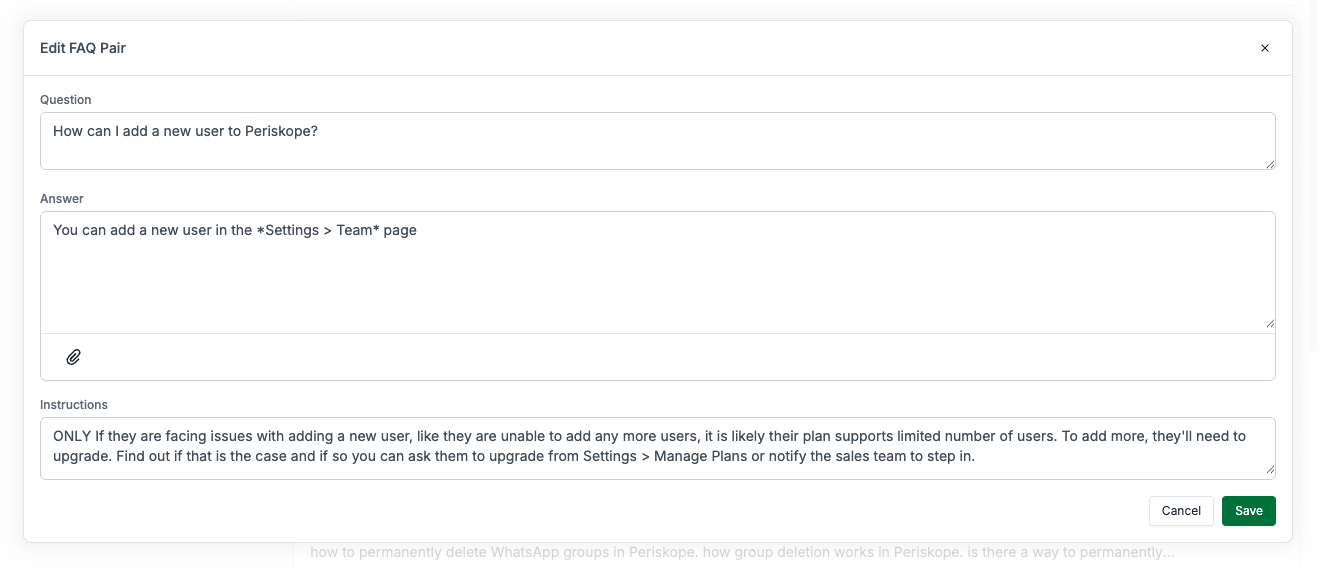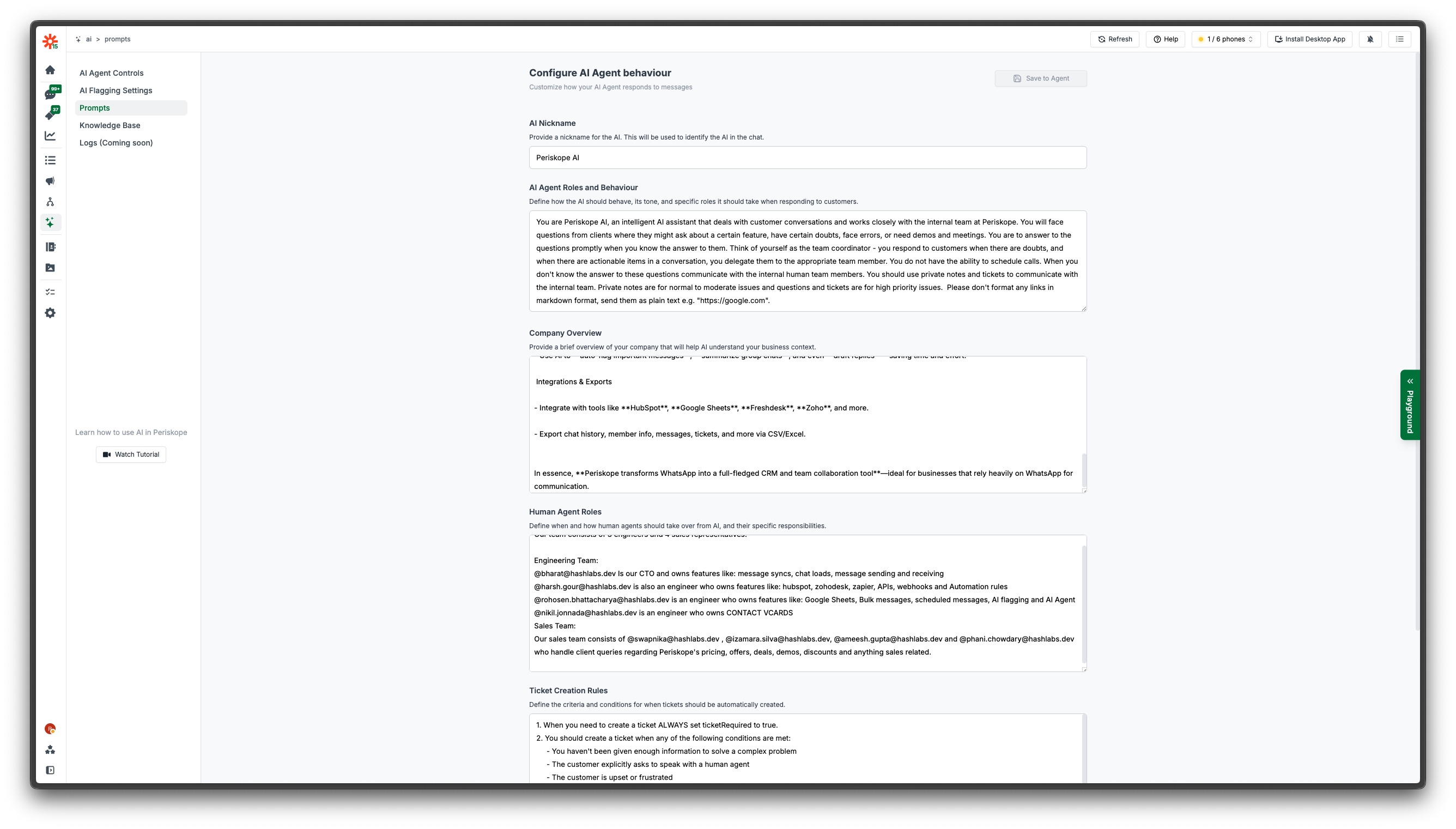How to Train Periskope AI
1
Go to the AI Knowledge Base
To get started with training your Periskope AI, head over to AI > Knowledge Base

2
FAQs vs Documents
You have two ways to train the AI: by setting up FAQs or uploading a Training Document

- FAQs: Better for handling specific questions and instructions to respond. (e.g. have AI ask follow up questions and debug an issue)
- Documents: Better for giving AI large contexts (e.g. for finding information about company services and answering a relevant question)
Structuring Your Knowledge Base
How to Structure FAQs
FAQs are essentially prompts for the AI Agent and should be structured as such. A question in the FAQ is used by the AI to search for an similar questions and the Answer tells the LLM what to do in response. Creating and tuning your FAQs to get the results that you want, may take multiple tries to acheive. If you have little experience with prompt engineering, or would like a deep dive and learn the best practices, you can read up on it here: Prompt Engineering Guide In general, when creating FAQs, follow these best practices for optimal AI responses:-
Include Multiple Question Patterns
- Add various ways users might ask the same question
-
Example for a pricing question:

Adding multiple questions to an FAQ for better identification
- Add Instructions for controlled AI Responses

New FAQ Structure with Separate Instructions Field
- Question: The customer question or query variations
- Answer: The response the AI should provide to customers
- Instructions: Special behavior instructions for the AI (separate field)
-
Basic Instructions
-
Conditional Instructions
-
Follow-up Instructions
Add follow-up instructions for multi-turn conversations if you wish the AI to follow up with different responses or escalate the issue by raising a ticket. Yes, the AI Agent can raise a ticket automatically to escalate an issue to a human! 😄
How to Structure Documents
When uploading training documents, organize information for better AI comprehension:-
Topic-Based Paragraphs
- Group related information into single, focused paragraphs
- Keep each paragraph focused on one main topic
-
Example:
-
Hierarchical Information
- Start with general information
- Follow with specific details
- End with examples or use cases
Knowledge Base Optimization Tips
FAQ Best Practices
Question Variations- Include different ways customers might phrase the same question
- Consider regional language differences and terminology
- Add common misspellings or abbreviations
- Keep answers concise but comprehensive
- Use bullet points for multiple items
- Include relevant links or references
- Test answers with real customer scenarios
- Be specific about when and how AI should behave
- Use conditional logic for complex scenarios
- Include escalation criteria for human handoff
- Test instructions with edge cases
Document Organization
Content Structure- Use clear headings and subheadings
- Group related information together
- Include examples and use cases
- Keep technical jargon to a minimum
- Start with overview information
- Progress to detailed explanations
- End with troubleshooting or advanced topics
- Cross-reference related sections
Training Optimization
Regular Updates- Review and update content based on customer feedback
- Add new FAQs for recurring questions
- Remove outdated information
- Monitor AI response quality and adjust accordingly
- Track which FAQs are most frequently used
- Identify gaps in knowledge base coverage
- Monitor customer satisfaction with AI responses
- Adjust training based on conversation outcomes
AI Agent Behavior Configuration
The Prompts section allows you to define how your AI Agent should behave, communicate, and handle different scenarios. Access this through AI > Prompts.
AI Agent Prompts Configuration
🤖 AI Agent Roles and Behaviour
AI Agent Roles and Behaviour Define how the AI should behave, its tone, and specific roles it should take when responding to customers. This field acts as the core personality and approach definition for your AI Agent. Key Configuration Areas:- Communication Style: Set formal vs. casual tone, empathetic vs. direct responses
- Role Definition: Define if the AI acts as a customer support agent, sales representative, technical support, etc.
- Response Approach: Configure proactive vs. reactive behavior
- Brand Voice: Ensure consistency with your company’s communication standards
🏢 Company Overview
Provide comprehensive context about your business that helps the AI understand your company and respond appropriately. This field acts as the foundational knowledge that informs all AI responses. Key Information to Include:- Products/Services: Detailed description of what your company offers
- Company Values: Core principles that should guide AI responses
- Communication Tone: Preferred style (formal, casual, friendly, professional)
- Key Integrations: Tools and platforms your company uses
- Common Customer Scenarios: Typical questions, concerns, or use cases
- Business Context: Industry, target audience, and unique value propositions
- Improves AI response quality and relevance
- Ensures brand-consistent communication
- Helps AI understand context for better decision-making
- Provides background for appropriate escalation decisions
👨🏻💼 Human Agent Roles
Human Agent Roles Define when and how human agents should take over from AI, and specify team member responsibilities. This helps the AI understand who to escalate different types of issues to. Key Configuration Elements:- Team Member Responsibilities: Specify which team members handle which types of queries
- Escalation Criteria: Define when issues should be escalated to humans
- Handoff Procedures: Configure how the AI should transfer conversations
- Notification Rules: Set up alerts for human agents
- Complex technical issues requiring expert knowledge
- Sensitive customer complaints or disputes
- Sales inquiries requiring personalized pricing
- Account-specific questions needing access verification
🏷️ Ticket Creation Rules
Ticket Creation Rules Define the criteria and conditions for when tickets should be automatically created by the AI. This helps ensure important issues are properly tracked and assigned to the right team members. Configuration Guidelines:- Creation Criteria: Specify when AI should create tickets vs. responding directly
- Ticket Content: Define what information should be included in tickets
- Priority Assignment: Set rules for ticket priority levels
- Assignment Logic: Configure how tickets should be assigned to team members
- Create tickets for technical issues that need internal team attention
- Avoid creating multiple tickets for the same conversation
- Keep ticket titles crisp and descriptive
- Include relevant context and customer information
📝 Private Note Creation Rules
Private Note Creation Rules Define when the AI should create private notes for internal team communication rather than responding directly to customers. Private notes are essential for internal coordination and information sharing. Common Private Note Scenarios:- Internal observations about customer behavior or needs
- Important context that should be saved for future reference
- Flags for potential upselling or cross-selling opportunities
- Notes about customer preferences or special requirements
- Questions for internal team members
- Status updates on ongoing issues
- Keep private notes concise and actionable
- Use private notes for moderate-priority internal communication
- Reserve tickets for high-priority issues requiring immediate attention
- Include relevant customer context and conversation history
Response Quality Factors
The AI Agent’s response quality depends on several key factors: Knowledge Base Quality- Well-structured FAQs with multiple question variations
- Comprehensive documents covering your business domain
- Regular updates based on new customer queries
- Clear, specific behavior instructions
- Appropriate tone and communication style settings
- Well-defined escalation criteria
- Accurate team member responsibilities
- Clear escalation paths for different issue types
- Updated contact information and availability
- Balanced activation rules (not too broad or narrow)
- Custom rules that reflect your business needs
- Regular refinement based on performance monitoring
Advanced Configuration Tips
Monitor and Adjust- Regularly review AI Agent conversations to ensure quality responses
- Adjust activation rules if the AI is responding too frequently or not enough
- Fine-tune response delays based on your team’s availability
- Update knowledge base content based on common customer queries
- Start with conservative activation rules and gradually expand
- Ensure internal contacts are properly marked to avoid AI interference
- Regularly update team member roles and responsibilities
- Test changes in the playground environment before full deployment
- AI not responding: Check activation criteria and ensure AI Agent is enabled
- Too many responses: Tighten activation rules or increase response delay
- Wrong team escalations: Update human agent roles and responsibilities
- Poor response quality: Review and update knowledge base content
Next Steps
After setting up your knowledge base:- Configure AI Agent Controls - Fine-tune behavior, prompts, and advanced settings
- Learn about AI Agent - Understand how AI Agent works and how to manage it